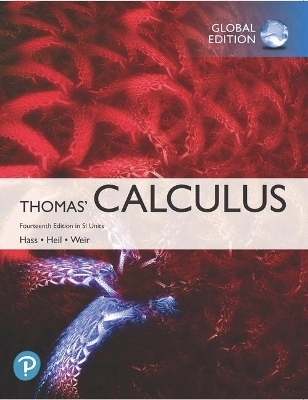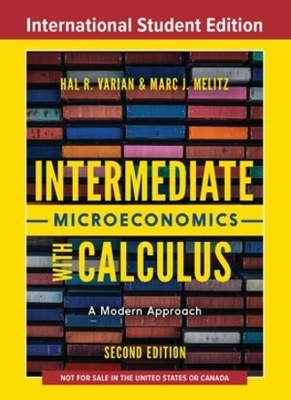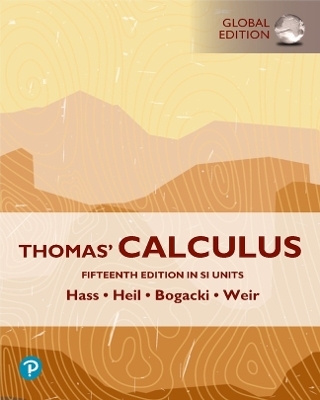
Thomas' Calculus, SI Units + MyLab Mathematics with Pearson eText (Package)
Pearson Education Limited
978-1-292-25333-6 (ISBN)
- Titel erscheint in neuer Auflage
- Artikel merken
Deepen your calculus knowledge with this new edition of Thomas’ time-tested text Thomas’ Calculus in SI Units, 14th edition, Global Edition, helps you reach the level of mathematical proficiency needed to excel in your course. The text supports your development with a balance of clear and intuitive explanations, current applications, and generalised concepts – going beyond simply memorising formulas and routine procedures. Its chapters help you to generalise key concepts and develop a deeper understanding of the topics covered.
In this 14th SI edition, authors Christopher Heil and Joel Hass have carefully examined every word and illustration with your needs as a modern student in mind. This edition preserves everything best about Thomas' time-tested text, resulting in an authoritative yet refreshingly modern book that meets the needs of today's students.
With a host of learning features built into the text, Thomas' Calculus is the perfect guide for students of mathematics, engineering, or science.
Also available with MyLab® Math MyLab is the teaching and learning platform that personalises the learning experience and improves results for each student.
If you would like to purchase the physical text and MyLab® Math, search for:
9781292253336 Thomas’ Calculus, Global Edition, 14th Edition plus MyLab Math with Pearson eText.
Package consists of:
9781292253220 Thomas' Calculus, Global Edition, 14th Edition
9781292253282 Thomas' Calculus, Global Edition, 14th Edition MyLab® Math
9780997880922 Thomas' Calculus, Global Edition, 14th Edition Pearson eText
MyLab® is not included. If MyLab is a recommended component of the course, ask your instructor for the correct ISBN. MyLab should only be purchased when required. Instructors, contact your Pearson representative for more information.
This title is a Pearson Global Edition. The Editorial team at Pearson has worked to include content relevant to students outside the United States.
Comes with a Companion Website
Joel Hass received his PhD from the University of California, Berkeley. He is currently a Professor of Mathematics at the University of California Davis. He has co-authored widely used calculus texts as well as calculus study guides. Hass’s current areas of research include the geometry of proteins, three-dimensional manifolds, applied maths, and computational complexity. Christopher Heil received his PhD from the University of Maryland. He is currently a Professor of Mathematics at the Georgia Institute of Technology. He is the author of a graduate text on analysis and a number of highly cited research survey articles. Heil's current areas of research include redundant representations, operator theory, and applied harmonic analysis. Maurice D. Weir (late) of the the Naval Postgraduate School in Monterey, California, was Professor Emeritus as a member of the Department of Applied Mathematics. He held a DA and MS from Carnegie-Mellon University and received his BS at Whitman College. He co-authored eight books, including University Calculus and Thomas’ Calculus.
1. Functions
1.1 Functions and Their Graphs
1.2 Combining Functions; Shifting and Scaling Graphs
1.3 Trigonometric Functions
1.4 Exponential Functions
2. Limits and Continuity
2.1 Rates of Change and Tangent Lines to Curves
2.2 Limit of a Function and Limit Laws
2.3 The Precise Definition of a Limit
2.4 One-Sided Limits
2.5 Limits Involving Infinity; Asymptotes of Graphs
2.6 Continuity
3. Derivatives
3.1 Tangent Lines and the Derivative at a Point
3.2 The Derivative as a Function
3.3 Differentiation Rules
3.4 The Derivative as a Rate of Change
3.5 Derivatives of Trigonometric Functions
3.6 The Chain Rule
3.7 Implicit Differentiation
3.8 Related Rates
3.9 Linearization and Differentials
4. Applications of Derivatives
4.1 Extreme Values of Functions on Closed Intervals
4.2 The Mean Value Theorem
4.3 Monotonic Functions and the First Derivative Test
4.4 Concavity and Curve Sketching
4.5 Applied Optimization
4.6 Newton’s Method
4.7 Antiderivatives
5. Integrals
5.1 Area and Estimating with Finite Sums
5.2 Sigma Notation and Limits of Finite Sums
5.3 The Definite Integral
5.4 The Fundamental Theorem of Calculus
5.5 Indefinite Integrals and the Substitution Method
5.6 Definite Integral Substitutions and the Area Between Curves
6. Applications of Definite Integrals
6.1 Volumes Using Cross-Sections
6.2 Volumes Using Cylindrical Shells
6.3 Arc Length
6.4 Areas of Surfaces of Revolution
6.5 Work and Fluid Forces
6.6 Moments and Centres of Mass
7. Transcendental Functions
7.1 Inverse Functions and Their Derivatives
7.2 Natural Logarithms
7.3 Exponential Functions
7.4 Exponential Change and Separable Differential Equations
7.5 Indeterminate Forms and L’Hôpital’s Rule
7.6 Inverse Trigonometric Functions
7.7 Hyperbolic Functions
7.8 Relative Rates of Growth
8. Techniques of Integration
8.1 Using Basic Integration Formulas
8.2 Integration by Parts
8.3 Trigonometric Integrals
8.4 Trigonometric Substitutions
8.5 Integration of Rational Functions by Partial Fractions
8.6 Integral Tables and Computer Algebra Systems
8.7 Numerical Integration
8.8 Improper Integrals
9. Infinite Sequences and Series
9.1 Sequences
9.2 Infinite Series
9.3 The Integral Test
9.4 Comparison Tests
9.5 Absolute Convergence; The Ratio and Root Tests
9.6 Alternating Series and Conditional Convergence
9.7 Power Series
9.8 Taylor and Maclaurin Series
9.9 Convergence of Taylor Series
9.10 Applications of Taylor Series
10. Parametric Equations and Polar Coordinates
10.1 Parametrizations of Plane Curves
10.2 Calculus with Parametric Curves
10.3 Polar Coordinates
10.4 Graphing Polar Coordinate Equations
10.5 Areas and Lengths in Polar Coordinates
10.6 Conic Sections
10.7 Conics in Polar Coordinates
11. Vectors and the Geometry of Space
11.1 Three-Dimensional Coordinate Systems
11.2 Vectors
11.3 The Dot Product
11.4 The Cross Product
11.5 Lines and Planes in Space
11.6 Cylinders and Quadric Surfaces
12. Vector-Valued Functions and Motion in Space
12.1 Curves in Space and Their Tangents
12.2 Integrals of Vector Functions; Projectile Motion
12.3 Arc Length in Space
12.4 Curvature and Normal Vectors of a Curve
12.5 Tangential and Normal Components of Acceleration
12.6 Velocity and Acceleration
| Erscheint lt. Verlag | 15.7.2019 |
|---|---|
| Verlagsort | Harlow |
| Sprache | englisch |
| Maße | 215 x 275 mm |
| Gewicht | 2180 g |
| Themenwelt | Mathematik / Informatik ► Mathematik ► Analysis |
| ISBN-10 | 1-292-25333-9 / 1292253339 |
| ISBN-13 | 978-1-292-25333-6 / 9781292253336 |
| Zustand | Neuware |
| Informationen gemäß Produktsicherheitsverordnung (GPSR) | |
| Haben Sie eine Frage zum Produkt? |
aus dem Bereich



